On Saturday 11th June members of the forum travelled to London to experience first-hand the new East-West and North-South fully segregated cycleways. We were extremely fortunate to have infrastructure expert and blogger Mark Treasure as our guide for the day.
Our tour began at Farringdon station, currently the northern-most extension of the N-S route. We headed south to Blackfriars where the two routes intersect. The old southern slip-road from Blackfriars Bridge down to Victoria Embankment is now given over to a cycle track. When completed in the autumn the route will extend north all the way to Kings Cross.
From Blackfriars we headed east along the E-W route to Tower Hill. Here the route has good connections to the existing CS3 route out to Barking. There is currently however no good access to Tower Bridge.
The E-W route currently runs from Parliament Square in the west to Tower Hill in the east. Eventually the route will extend westwards through Hyde Park to Lancaster Gate and beyond.
Through the City the route takes a slight detour at Castle Baynard Street (essentially a tunnel providing access to the backs of the offices). This is shared with motor traffic but is not a through route and traffic should be light. The walls of the tunnel have been painted white to brighten it up a bit and extra lighting has been installed. It still feels gloomy but does at least shelter you from the rain!
Changing perceptions
One of the less tangible benefits of having fully segregated routes is how it changes the way you look at the city. Without having to constantly watch out that you’re not about to be be squashed by a bus or a taxi you have time to take in the amazing and varied architecture of central London. It won’t be long before taking a bike tour becomes one of the “top ten things to do” for visitors.
Travelling by bike really has become the best way to see the city, easily on a par with a ride atop an open top bus. Approaching the Houses of Parliament along the Embankment you get glorious views of Big Ben. You realise how compact London is. Riding on segregated cycleways transforms not just the physical experience of getting about but also how you perceive London.
You can of course also ride alongside and chat with your companion.
You can already see a change in the way people ride. People are generally riding slower and sitting more upright. The practical Dutch-style roadster bike is now becoming more common. With your head upright you can easily take in everything around you rather than focusing on the exhaust pipe of the car in front of you.
From Tower Hill we retraced our steps back to Blackfriars, crossed the bridge and headed south along Blackfriars Road to Elephant and Castle.
At St George’s Cross the route turns right down Lambeth Road, the only section of the route not segregated from motor traffic. This is a relatively quiet one-way street for cars and is mainly used for bus parking but is still not really suitable for families or unaccompanied children, which is surprising given there are two schools close by.
Arriving at Elephant and Castle is still a bewildering and scary experience. There is no obvious way to get across or around the junction other than by diving into the melee of cars and buses. The old roundabout has been “tamed” by closing one side to traffic which has created a new public space on the southern end. To reach this you have to negotiate a two-stage crossing. The central refuge only has room for about five bikes which will easily fill up in busy times with bikes spilling out into the junction.
Leaving Elephant and Castle we stopped for lunch at a coffee shop which, due to the central refuge created by the superhighway, now has cycle parking conveniently located right outside.
Blackfriars Road feels the most transformative. The cycleway here is both wide and straight and there are wide central areas with space for cycle parking, benches etc. It was already noticeable how the behaviour of cyclists changes when given good facilities. In a whole day of riding we witnessed no aggression or dangerous behaviour: just lots of people getting about by bike.
As for what was happening on the road it might as well have been in a different city. We were totally unaffected by what was going on with the cars, buses and taxis. Previously on a trip like this we would have experienced plenty of close shaves with motor traffic. Instead, stress levels hardly rose about walking levels. As one rider observed: “It’s like we’re in a parallel world.”
After our lunch stop we headed back to Blackfriars and then west along the Embankment to the Houses of Parliament. This section is in many ways the “jewel in the crown” with fabulous views over the river and a boulevard feel to it. The E-W route currently ends just west of Parliament Square but construction work is continuing all the way through to Hyde Park.
The pace of construction is impressive. The skills clearly do exist in the UK to build world-class cycling infrastructure and build it quickly. Space for the cycleways has been created mostly without taking away any lanes for motorised traffic. This has largely been achieved by narrowing the existing lanes and by using space from the old on-road cycle lanes and occasionally by taking away a bit of pavement.
Conditions for pedestrians have been considerably improved along with the cycleways. For instance, at the Farringdon Street/Fleet Street crossroads there are now light-controlled pedestrian crossings, making the junction pleasanter and safer for pedestrians. In many areas pavements have been widened as well.
Making connections
With the use of bi-directional tracks down one side of the road (rather than “with-flow” lanes on either side) how you join and leave the routes is crucial. Many junctions use a two-stage crossing. So for example to turn right you would first pull off to the left and sit in a holding area while you wait for the signal to cross. It’s very early days but these did appear confusing. It was not clear at all where you were supposed to go.
The E-W route doesn’t yet link up with CS2 at Aldgate which seems a surprising omission. To the south you can access CS7 over Southwick Bridge, albeit via a two-stage crossing.
Some side roads don’t yet have light-controlled crossing for cyclists to enable people to easily join the cycleway.
The width of the path is mostly a generous 4m, which gives ample space for two couples riding side-by-side to comfortably pass each other. Rather annoying however the section along Victoria Embankment is just under 4m in places which makes side-by-side riding a bit of a squeeze.
The overwhelming response of everyone on the ride was how relaxing, safe and convenient the routes were. Those of us in less-fortunate regions of the UK now have some home-grown cycling infrastructure we can point to and say: “Build us one of those!”
Our tour ended with tea and cake by the Serpentine before heading to Victoria for the train home.
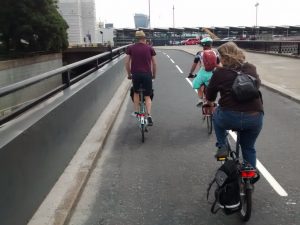
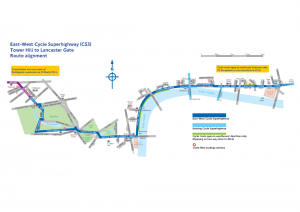
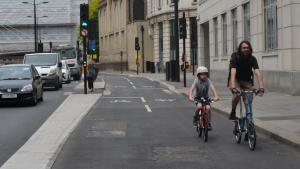
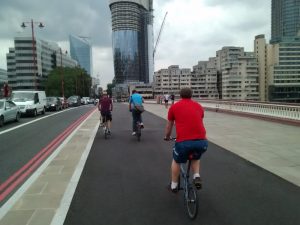
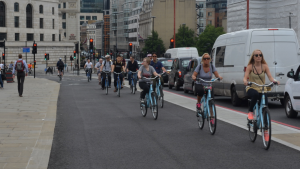
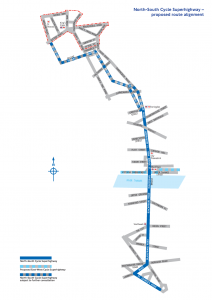
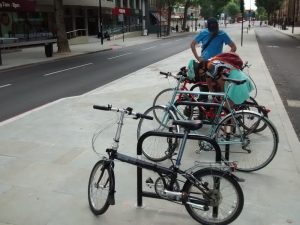
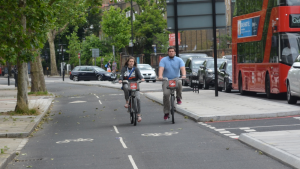
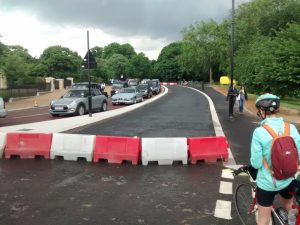
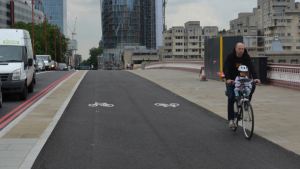

A thoroughly informative account, and a pleasure to read; oh, and well done for including the maps – so often forgotten in such reports and so vital to a proper understanding!
We in the Tunbridge Wells Bicycle Users Group have been keen to persuade Kent transport planners to accompany us on a tour of cycling infrastructure in Holland. This has not been easy, so emboldened by your positive remarks we may focus on London instead.
Peter, many thanks for the excellent feed back on your (and the rest of the party’s experience). It really shows what can be done if there is the political will. The clear lesson is that if it can be done in London with all the challenges that presents there really is not an excuse for not doing it in Horsham! and other towns and cities across the UK.
Peter, Well done to you and the party that have provided a really helpful report back on your trip. As someone who has never wanted to ride through London before you have made it sound most attractive and I will definitely give it a try – it sounds blissful. Thank you HDCF and let’s be hopeful that one day we can have tourists coming to Horsham to sample our scenic Cycle Paths !